Although travel is restricted at the moment for some of us, I can still take you on a virtual tour in my article. Well, I’m leading you inside the Residenz Palace in Munich and introducing you to some exclusive jewels on the way.
Are you aboard this journey?

Bavarian Kings.
The Bavarian Crown Jewels are a set of crown jewels created for the Kingdom of Bavaria, which existed from 1806 to 1918. They were created by the former Duke of Bavaria, now King of Bavaria, the title held by the hereditary Wittelsbach rulers of Bavaria. The crown jewels commissioned by Maximilian I; were never worn in public but were displayed on a cushion on occasions like the king’s ascension or his funeral.
These magnificent Bavarian Crown Jewels along with a few goldsmith’s works are displayed in the Treasury of the Residenz Palace in Munich, the former palace of the Bavarian monarchs.
Let’s explore the jewels inside the Palace Museum!
Royal Insignia:
In 1806, Elector Maximilian Joseph IV of Bavaria proclaimed King Maximilian Joseph I of Bavaria and the Royal Insignia were commissioned from craftsmen in Paris.
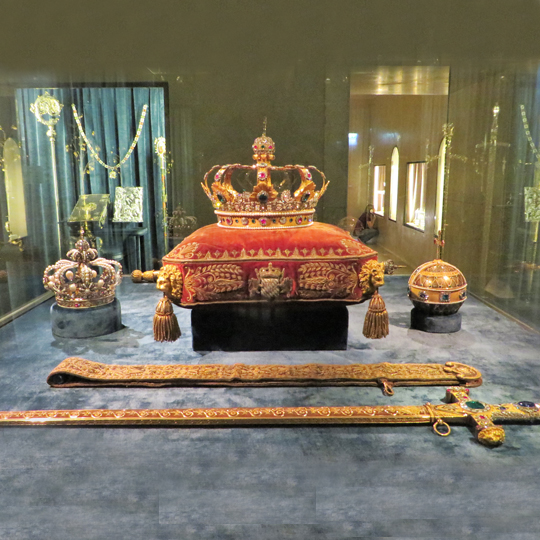
The Regalia included
1. The King Crown.
2. State Sword.
3. Royal Orb.
4. Royal Sceptre.
5. Crown of the Queens of Bavaria.
The King’s Crown:
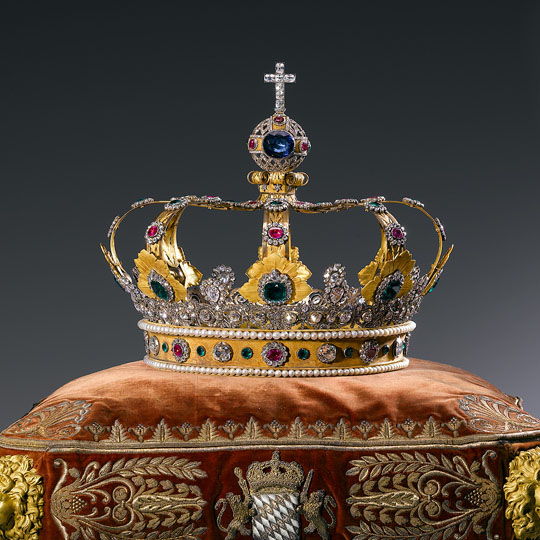
The King’s Crown is embellished with rubies, diamonds, emeralds, sapphires, pearls and the famous Wittelsbach Diamond, which was later removed and sold by the Wittelsbach.

Image 1: Wittelsbach Diamond set in the Order of the Golden Fleece.
Image 2: Mounted as a hair ornament.
Image 3: Wittelsbach Diamond set in The King’s Crown.
Image 4: Wittelsbach-Graff.
The journey of the famous Indian origin Wittelsbach Diamond is as below:
• The original Wittelsbach Diamond, a 35.56cts VS2, fancy deep greyish-blue diamond also known as Der Blaue Wittelsbacher came to Munich in 1722 when Maria Amalia married Charles of Bavaria; a member of the Wittelsbach family.
• In 1745, the Wittelsbach Diamond was first mounted on the Bavarian Elector’s Order of the Golden Fleece.
• When Maximilian IV Joseph von Wittelsbach became the first King of Bavaria in 1806, he commissioned a royal crown displaying the diamond. Until 1918, the jewel remained on top of the crown.
• The Wittelsbach Diamond was removed and sold by the Wittelsbach family in 1931.
• Later, in 2008 this 35.56cts Wittelsbach Diamond was sold to Laurence Graff, who recut the diamond in 2010 to enhance the colour and clarity resulting in a 31.06cts deep blue diamond with IF clarity and renamed it Wittelsbach-Graff.
• Wittelsbach-Graff was sold to the former emir of Qatar, Hamad bin Khalif in 2011.
Golden Royal Orb, State Sword and Royal Sceptre:

Golden Royal Orb is embellished with pearls, diamonds, ruby and sapphire.
The State Sword is 96cms long and The Royal Sceptre is 89 cms long surmounted by a small round crown on the top.
Crown of the Queens of Bavaria:

The crown of Karoline of Baden; the Queen of Bavaria is embellished with huge pearls, diamond, ruby and emeralds; just like the other Crown Jewels it too wasn’t worn during official ceremonies,
This crown is the epitome of the striking beauty and royalty of diamonds and pearls. What do you think of this piece from the Royal Regalia? Let me know in the comments!
Ruby and Spinel Diadem:
Wonder why is the famous Oktoberfest Festival celebrated how is it connected to Bavarian jewels? Read on!

Princess Antonia wife of Crown Prince Rupprecht of Bavaria adorned in the parure.
Bavarian crown prince Ludwig I; marriage to Therese Charlotte Luise of Saxony-Hildburghausen in 1810, marks the occasion of celebrating the first-ever Oktoberfest. This gorgeous Ruby and Spinel diadem which included a tiara, bracelets, necklace and earrings was a wedding gift from the Bavarian crown prince.
Now, every time I celebrate Octoberfest, I will surely remember this fabulous diadem! Will you? Let me know in the comments.
Bavarian Lover’s Knot Tiara:
The tiara was commissioned by King Ludwig I of Bavaria for his wife Queen Therese.

The Tiara is made with sixteen pearls in diamond arches, ranging from lover’s knot bows and mirrored by sixteen pear-shaped pearls on top. The tiara along with pearl chandelier earrings and a large pearl necklace is displayed at the Treasury of the Residenz Palace in Munich.
The story goes that Queen Therese gave the tiara to her daughter-in-law, Duchess Amalia of Oldenburg who became the Queen consort from 1836 to 1862 on marrying Queen Therese’s second son Otto I. Since the couple didn’t have any children, they were exiled to Bavaria in 1862 and the jewels were inherited by the Queens of Bavaria.
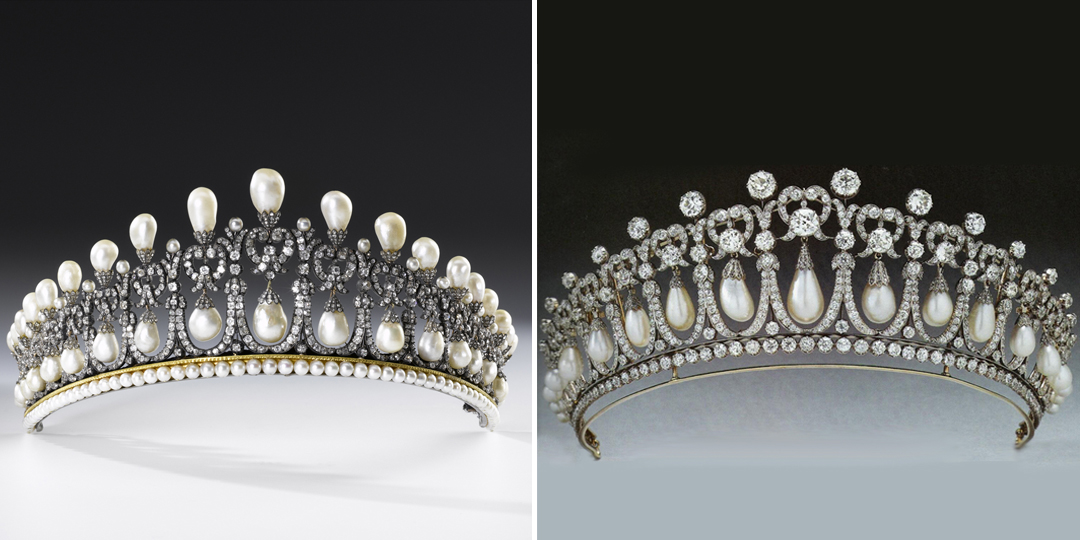
Image 1: Bavarian Lover’s Knot Tiara
Image 2: Cambridge Lover’s Knot Tiara and Queen Mary’s Lover’s Knot Tiara
Did you notice a close resemblance between the Bavarian Lover’s Knot Tiara and Cambridge Lover’s Knot Tiara and Queen Mary’s Lover’s Knot Tiara? Let me know in the comments.
Bavarian Stomacher:
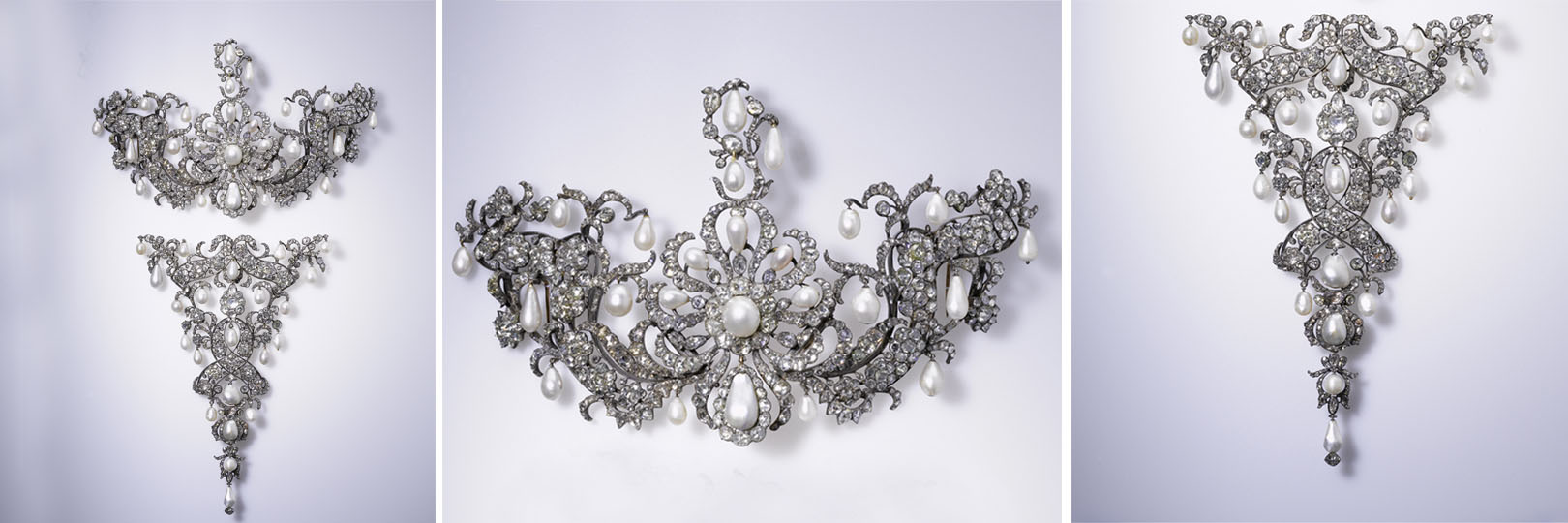
Stomacher also known as Devant De Corsage were popular from the 18th until the beginning of the 20th century. Made of one or more elements stomachers could be worn as a small individual independent brooch or as a single large corsage brooch fitted on the centre panel of the bodice. However, over some time, stomachers went out of fashion and the large corsage brooches were broken and reworked into smaller brooches.
Featured above is a Stomacher made with teardrop pearls and diamonds.
The Crown of Princess Blanche:
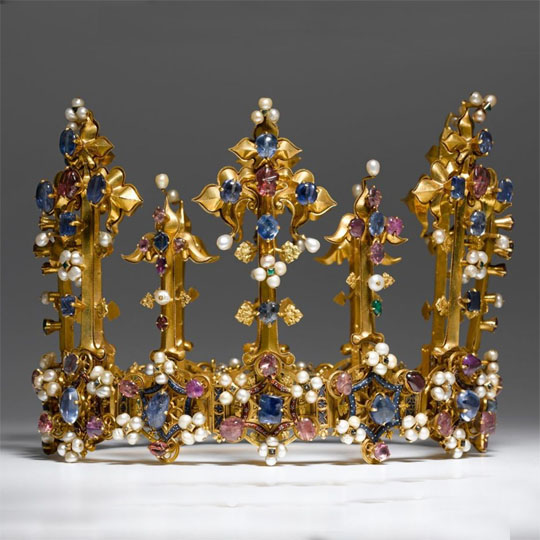
The Crown of Princess Blanche also known as The Palatine Crown or Bohemian Crown, c1370–80 has been a property of the House of Wittelsbach since 1402. The enamel detailing on the crown has been discribed as “One of the finest achievements of the Gothic goldsmith”.
The Crown of Henry II:
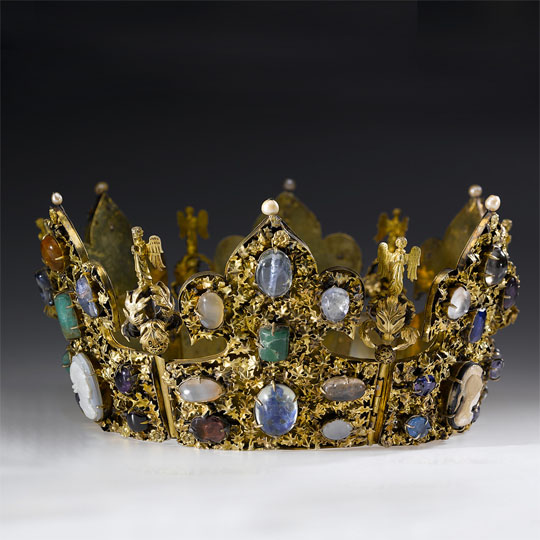
This medieval crown was transferred to the treasury of the Munich Residenz when Bamberg became part of the Kingdom of Bavaria. The crown consists of six plates adorned with precious stones and antique cameos on 2 plates joined together by hinges fixed with pins.
Palatine Lion:
Let’s say hello to the “King of Beasts”. A lion has always been a great symbol of inspiration with its spirit and a heart full of courage, strength, and confidence.

Featured above is a Palatine Lion hanging from a chain of seven links with a green-enamelled hoop set with emeralds c 1570/80. Did you notice the pearl held in its paws, the table cut diamonds and gold work?
The Statuette of St. George:
Saint George was a highly respected soldier who became the symbol of the heroic fighter against evil.
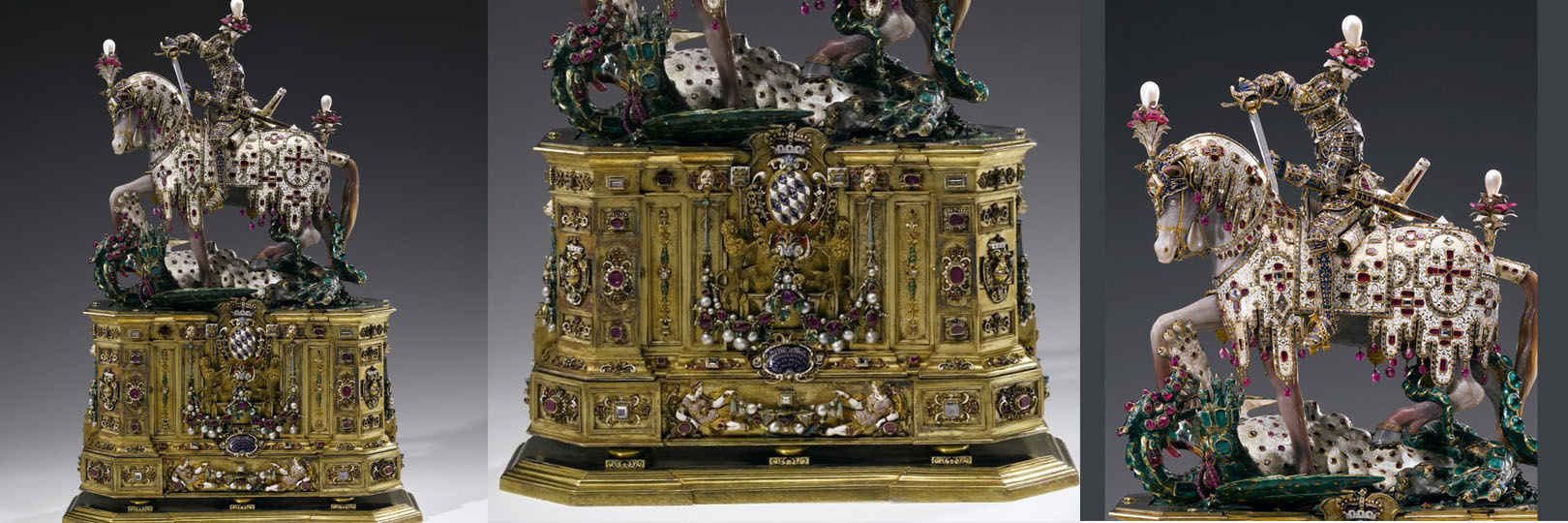
The Statuette of St George is embellished with gemstones and crafted with gold and silver detailing. The Statuette also serves as a reliquary for the base compartment stores the body parts of the saint (1586-97). The detailed craftsmanship of this piece is a wonderful tribute to St. George’s heroism, isn’t it?
The Sapphire Cup:
Many royal families have been fascinated with bejewelled objects. I would share an exclusive Sapphire cup made for Duke Albrecht V of Bavaria

The cup is covered in white enamel, inlaid with delicate gold leaf-and-tendril ornament, studded with thirty-six large sapphires and decorated in gold and coloured enamels.
Did you notice the warrior in Classical armour on the lid holding a sapphire carved ring?
The Palatinate Pearl:
This is one of the very rare pearl, which though exhibited at the Treasury of the Residenz Palace in Munich is not a part of the Crown jewels. Did you notice that the pearl is partially black and white?

The pearl is set between two diamond-encrusted snakes, extending from a bed of leaves, flanked by two flowers. The story goes that the pearl gets its name from one of the royal family members of Bavaria who was ruling Palatinate. It later arrived in Munich during the late eighteenth century with its owner The count of the Palatine Charles Theodore.
With this, it’s a wrap! It’s such a delight to discover these rare and majestic treasures and I can’t wait to explore them in person.
Credit: Schloesserverwaltung Bayern and Pratiek Dhadha.
Disclaimer: The above images belong to their respective sources, where rights may be held. Usage here is for information/reference purpose only.
